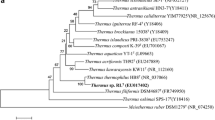Abstract
A novel thermophilic, anaerobic, rod-shaped bacterium strain, designated Buff, was isolated from buffalo-dung samples collected from a buffalo-farm located in Caserta (Campania, south of Italy). Strain Buff was Gram-positive, motile and no spore-forming. The growth temperature range was 40–65°C with an optimum at 60°C, while pH growth range at 60°C was 5.5–8.0 with an optimum at about pH 6.5. NaCl growth concentration ranged from 0 to 2.0% with an optimum at 0.5% (w/v); no growth was observed with the presence of NaCl 3.0% (w/v). The strain produced ethanol, acetate, lactate, H2, H2S and CO2 by glucose fermentation. The DNA G + C content was 34.4 mol%. As determined by 16S rRNA sequence analysis, this organism belonged to the genus Thermoanaerobacterium. On the basis of the physiological and molecular properties, we propose for strain Buff the new species designation Thermoanaerobacterium thermostercus sp. nov. This novel organism represents the first species of the genus Thermoanaerobacterium isolated from buffalo-dung. The type strain is Buff (=DSM 22141 = ATCC BAA-1776).


Similar content being viewed by others
References
Cann IKO, Stroot PG, Mackie KR, White BA, Mackie RI (2001) Characterization of two novel saccharolytic, anaerobic thermophiles, Thermoanaerobacterium polysaccharolyticum sp nov. and Thermoanaerobacterium zeae sp. nov., and emendation of the genus Thermoanaerobacterium. Int J Syst Evol Microbiol 51:293–302
Collins MD, Lawson PA, Willems A, Cordoba JJ, Fernandez-Garayzabal J, Garcia P, Cai J, Hippe H, Farrow JAE (1994) The phylogeny of the genus Clostridium: proposal of five new genera and eleven new species combinations. Int J Syst Bacteriol 44:812–826
Halebian S, Harris B, Finegold SM, Rolfe R (1981) Rapid method that aids in distinguishing Gram-positive from Gram-negative anaerobic bacteria. J Clin Microbiol 13:444–448
Kimura M (1980) A simple method for estimating evolutionary rate of base substitutions through comparative studies of nucleotide sequences. J Mol Evol 16:111–120
Kublanov IV, Prokofeva MI, Kostrikina NA, Kolganova TV, Tourova TP, Wiegel J, Bonch-Osmolovskaya EA (2007) Thermoanaerobacterium aciditolerans sp nov., a moderate thermoacidophile from a Kamchatka hot spring. Int J Syst Evol Microbiol 57:260–264
Lama L, Calandrelli V, Gambacorta A, Nicolaus B (2004) Purification and characterization of thermostable xylanase and β-xylosidase by the thermophilic bacterium Bacillus thermantarcticus. Res Microbiol 155:283–289
Lee YE, Jain MK, Lee C, Lowe SE, Zeikus JG (1993) Taxonomic distinction of saccharolytic thermophilic anaerobes: description of Thermoanaerobacterium xylanolyticum gen. nov., sp. nov., and Thermoanaerobacterium saccharolyticum gen. nov., sp. nov.; reclassification of Thermoanaerobium brockii, Clostridium thermosulfurogenes, and Clostridium thermohydrosulfuricum E100-69 as Thermoanaerobacter brockii comb. nov., Thermoanaerobacterium thermosulfurigenes comb. nov., and Thermoanaerobacter thermohydrosulfuricus comb. nov., respectively; and transfer of Clostridium thermohydrosulfuricum 39E to Thermoanaerobacter ethanolicus. Int J Syst Bacteriol 43:41–51
Lee YJ, Mackie RI, Cann IK, Wiegel J (2008) Description of Caldanaerobius fijiensis gen. nov., sp. nov., an inulin-degrading, ethanol-producing, thermophilic bacterium from a Fijian hot spring sediment, and reclassification of Thermoanaerobacterium polysaccharolyticum and Thermoanaerobacterium zeae as Caldanaerobius polysaccharolyticus comb. nov. and Caldanaerobius zeae comb. nov. Int J Syst Evol Microbiol 58:666–670
Liu SY, Rainey FA, Morgan HW, Mayer F, Wiegel J (1996) Thermoanaerobacterium aotearoense sp. nov., a slightly acidophilic, anaerobic thermophile isolated from various hot springs in New Zealand, and emendation of the genus Thermoanaerobacterium. Int J Syst Bacteriol 46:388–396
Poli A, Romano I, Cordella P, Orlando P, Nicolaus B, Ceschi Berrini C (2009) Anoxybacillus thermarum sp nov., a novel thermophilic bacterium isolated from thermal mud in Euganean hot springs, Abano Terme, Italy. Extremophiles 13:867–874
Posada D, Buckley TR (2004) Model selection and model averaging in phylogenetics: advantages of akaike information criterion and bayesian approaches over likelihood ratio tests. Syst Biol 53:793–808
Posada D, Crandall KA (1998) MODELTEST: testing the model of DNA substitution. Bioinformatics 14:817–818
Rainey FA, Ward NL, Morgan HW, Toalster R, Stackebrandt E (1993) Phylogenetic analysis of anaerobic thermophilic bacteria: aid for their reclassification. J Bacteriol 175:4772–4779
Romano I, Manca MC, Lama L, Nicolaus B, Gambacorta A (1993) A method for antibiotic assay on Sulfolobales. Biotechnol Tech 7:439–440
Romano I, Nicolaus B, Lama L, Manca MC, Gambacorta A (1996) Characterization of a haloalkalophilic strictly aerobic bacterium, isolated from Pantelleria Island. Syst Appl Microbiol 19:326–333
Romano I, Lama L, Orlando P, Nicolaus B, Giordano A, Gambacorta A (2007) Halomonas sinaiensis sp nov., a novel halophilic bacterium isolated from a salt lake inside Ras Muhammad Park, Egypt. Extremophiles 11:789–796
Ronimus RS, Parker LE, Morgan HW (1997) The utilization of RAPD-PCR for identifying thermophilic and mesophilic Bacillus species. FEMS Microbiol Lett 147:75–79
Swofford DL (2002) PAUP*: phylogenetic analysis using parsimony (* and other methods), Version 4.0b10. Sinauer Associates, Sunderland
Thompson JD, Gibson TJ, Plewniak F, Jeanmougin F, Higgins DG (1997) The CLUSTAL_X windows interface: flexible strategies for multiple sequence alignment aided by quality analysis tools. Nucleic Acids Res 25:4876–4882
Versalovic J, Schneider M, De Bruijn FJ, Lupski JR (1994) Genomic fingerprint of bacteria using repetitive sequence-based polymerase chain reaction. Methods Mol Cell Biol 5:25–40
Xue Y, Xu Y, Liu Y, Ma Y, Zhou P (2001) Thermoanaerobacter tengcongensis sp nov., a novel anaerobic, saccharolytic, thermophilic bacterium isolated from a hot spring in Tengcong, China. Int J Syst Evol Microbiol 51:1335–1341
Acknowledgments
The authors thank Valeria Calandrelli and Vincenzo Mirra for excellent technical assistance; Dr. Cristoforo Silvestri for the critical reading of the manuscript and Davide Buono for his availability. This manuscript was supported by Italian framework project F.I.S.R. D.M. 17/02/2002—Metodologie innovative per la produzione di idrogeno da processi biologici.
Author information
Authors and Affiliations
Corresponding author
Additional information
Communicated by A. Driessen.
16S rRNA gene sequence of Thermoanaerobacterium thermostercus is available in the GenBank/EMBL/DDBJ databases under the accession number FM999998.
Rights and permissions
About this article
Cite this article
Romano, I., Dipasquale, L., Orlando, P. et al. Thermoanaerobacterium thermostercus sp. nov., a new anaerobic thermophilic hydrogen-producing bacterium from buffalo-dung. Extremophiles 14, 233–240 (2010). https://doi.org/10.1007/s00792-010-0303-x
Received:
Accepted:
Published:
Issue Date:
DOI: https://doi.org/10.1007/s00792-010-0303-x




